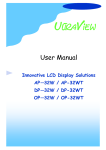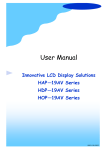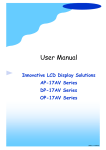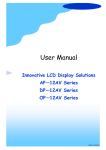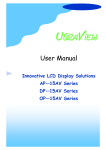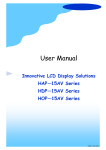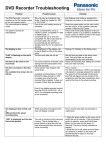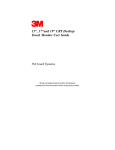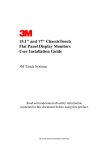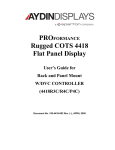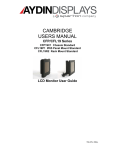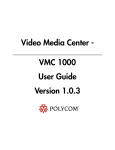Download 4. Using the System
Transcript
UltraView User Manual Innovative LCD Display Solutions AP—17W / AP-17WT DP—17W / DP-17WT OP—17W / OP-17WT AP-17 WT/ DP-17WT / OP-17WT Series User Manual 1. Table of Content 1. Table of Content 2. Introduction A) B) C) D) 3. Page.1 Overview Features Dimension Diagrams Technical Specifications Installation A) Package Contents B) Caution to the user C) Cleaning D) Precautions 4. Page.2 Page.2 Page.3-5 Page.6 Page.7 Page.7 Page.7 Page.8-9 Using the System A) B) C) D) Product Views I/O Outlet Installation Procedures Setup Touchscreen (Optional) i) For Windows ii) For DOS E) OSD Switch F) OSD Control G) Remote Control (Optional) Page.10-12 Page.13 Page.14 Page.15 Page.15 Page.16-18 Page.19 Page.20-27 Page.28 Disclaimer This information is subject to change without notice. The producer of this manual accepts no responsibility for damage or claims, resulting from misuse or misinterpretation. Jan 05 P.1 AP-17 WT/ DP-17WT / OP-17WT Series User Manual 2. Introduction A. Overview This LCD monitor incorporates 26”color active matrix thin-film-transistor (TFT) liquid crystal display to provide superior display performance. A maximum resolution of 1,280 x 768 is ideal for displaying complex graphics and high definition images. Other outstanding designs that enhance this LCD monitor’s performance are Plug & Play compatibility and OSD (On Screen Display) controls. B. Features ● High contrast color TFT LCD display, support resolution up to 1280 x 768. ● Advanced OSD control for picture quality adjustment. ● Slim and compact size ● Wide Viewing Angle Disclaimer This information is subject to change without notice. The producer of this manual accepts no responsibility for damage or claims, resulting from misuse or misinterpretation Jan 05 P.2 AP-17 WT/ DP-17WT / OP-17WT Series User Manual 2. Introduction C. Dimension Diagrams AP-17WT series 222 222 25 293 22 200 270 370 47 347 418 440 Disclaimer This information is subject to change without notice. The producer of this manual accepts no responsibility for damage or claims, resulting from misuse or misinterpretation. Jan 05 P.3 293 AP-17 WT/ DP-17WT / OP-17WT Series User Manual 2. Introduction C. Dimension Diagrams DP-17WT series 51 420 272 222 272 370 420 51 347 Disclaimer This information is subject to change without notice. The producer of this manual accepts no responsibility for damage or claims, resulting from misuse or misinterpretation. Jan 05 P.4 200 AP-17 WT/ DP-17WT / OP-17WT Series User Manual 2. Introduction C. Dimension Diagrams OP-17WT series 222 293 200 270 370 26 25 440 347 418 Disclaimer This information is subject to change without notice. The producer of this manual accepts no responsibility for damage or claims, resulting from misuse or misinterpretation. Jan 05 P.5 AP-17 WT/ DP-17WT / OP-17WT Series User Manual 2. Introduction Technical Specifications Monitor Panel SamSung 17" Widescreen LCD Panel Display Type TFT LCD active matrix color Resolutions 1,280 x 768 Response Time Tr=5ms, Tf=20ms Contrast Ratio 400:1 typical Brightness 450 cd/m2 typical Pixel Pitch 0.2895 x 0.2895 mm Panel Color 16.2M display color Viewing Angle 70 / 70 / 50 / 60 (L / R / U / D) Storage Temp. -20° to 60°C Operating Temp. 0° to 50°C MTBF 50,000 hours (Min.) Power Supply External Power Supply, 12VDC, 5A Cable Length from mains plug to adapter 182cm Cable Length from adapter Unit 180cm Power Socket IEC 320 Scart Video Scart 21-pin (female) x 1 RCA Video Composite Video (female) x 1 RCA Audio Composite Audio (female) x 2 in/out S-video S-video (female) x 1 Component Video Component (Y/Pb/Pr) x 1 VGA HDD D-sub 15 Pin (female) x 1 DVI-D DVI-D x 1 RF TV Antenna Available in television model only Power Supply Connectors AP Series : 440(W) x 293(H) x 53(D) mm Product Dimension DP Series : 420(W) x 270(H) x 51(D) mm OP Series : 440(W) x 293(H) x 51(D) mm Packing Dimension Net / Gross Weight Jan 05 AP / DP / OP Series : 570(W) x 425(H) x 160(D) mm AP Series : 10 Kg / 15 Kg DP Series : 8 Kg / 13 Kg OP Series : 8 Kg / 13 Kg Disclaimer This information is subject to change without notice. The producer of this manual accepts no responsibility for damage or claims, resulting from misuse or misinterpretation. AP-17 WT/ DP-17WT / OP-17WT Series User Manual 3. Installation A. Package Contents After unpacking the carton, check and see if the following items are included in good condition. Contact your supplier as soon as possible for replacing the missing / damaged items. ● 17” TFT LCD monitor ● 12VDC Power Adaptor ● VGA Cable (Male to Male) ● RCA Cable ● S-Video Cable ● Power Cord ● Mounting Bracket (AP Series only) ● User Manual ● CD Disc B. Caution to the users To assure continued FCC compliance, please use grounded power supply cord and the provided shielded video interface cable with bonded ferrite cores. If a BNC cable is going to be used, use only a shielded BNC (5) cable. Also, The Federal Communications Commission warns the user that any unauthorized changes or modifications to the unit if not expressly approved by the party responsible for compliance could void the user's authority of operating the equipment. C. Cleaning 1. Gently wipe screen with a clean camel hair lens brush, or a soft, clean, lint-free cloth. This removes dust and other particles that can scratch the screen. 2. Do not apply excessive pressure to the screen surface when wiping it clean because this may damage the LCD. 3. Do not pour or spray any liquid directly onto the screen or case of the LCD monitor. Chemical cleaners have been reported to damage the screen or case of the LCD monitor. Jan 05 P.7 AP-17 WT/ DP-17WT / OP-17WT Series User Manual 3. Installation D. Precautions Read all of these instructions and save them for later use. Follow all warnings and instructions on the product. Product ● Do not cover or block the vent holes in the case. ● Do not insert sharp objects or spill liquid into the LCD monitor through cabinet slots. They may cause accident fire, electric shock or failure. ● Disconnect the power plug from the AC outlet if you will not use it for an indefinite period of time. ● Do not attempt to service this product yourself, as opening or removing covers may expose you to dangerous voltage points or other risks. ● Do not touch the screen directly with your fingers. You may damage the screen, and oil from your skin in difficult to move. ● Do not apply pressure to screen. The LCD is very delicate. Power 1. Use the type of power indicated on the marking label. Plugs 1. Do not remove any of the prongs of the monitor’s three-pronged power plug. 2. Disconnect the power plug from the AC outlet under following conditions : Jan 05 ● If the product will not be used for an indefinite period time. ● When the power cord or plug is damaged or frayed. ● If the product does not operate normally when the operating instructions are followed. ● Adjust only those controls that are covered by the operating instructions. Improper adjustment of other controls may result in damage and will often require extensive work by a qualified technician to restore the product to normal operation. ● If the product has been dropped or the cabinet has been damaged. ● If the product exhibits a distinct change in performance, indicating a need for service. P.8 AP-17 WT/ DP-17WT / OP-17WT Series User Manual 3. Installation D. Precautions (Cont.) Power and extension cords 1. Do not allow anything to rest on the power cord. 2. Do not locate this product where persons will walk on the cord. 3. Use the proper power cord with correct attachment plug type. If the power source is 120V AC, use a power cord that has UL and C-UL approvals. If the power source is a 240V AC supply, use the tandem (T blade) type attachment plug with ground conductor power cord that meets the respective European country’s safety regulations, such as VDE for Germany. 4. Do not overload wall outlets or power cords. Ensure that the total of all units plugged into the wall outlet does not exceed 10 amperes. 5. Ensure that the total ampere ratings on all units plugged into the extension cord is not above the cord’s rating. 6. If the power supply cord, which came with your monitor, is to be connected to the PC instead of the wall outlet, this equipment is to be used with UL/TÜV approved computers with receptacle rated 100~240V AC, 50/60Hz, 1.0A(minimum). Environment 1. Place the monitor on a flat and leveled surface. 2. Place the monitor in a well-ventilated place. 3. Keep the monitor away from : Overly hot, cold or humid places, places directly under sunlight, dusty surroundings, equipment that generate strong magnetic fields. Jan 05 P.9 AP-17 WT/ DP-17WT / OP-17WT Series User Manual 4. Using the System A. Product Views AP Series - Front View AP Series - Rear View Jan 05 P.10 AP-17 WT/ DP-17WT / OP-17WT Series User Manual 4. Using the System A. Product Views (Cont.) DP Series - Front View DP Series - Rear View Jan 05 P.11 AP-17 WT/ DP-17WT / OP-17WT Series User Manual 4. Using the System A. Product Views (Cont.) OP Series - Front View OP Series - Rear View Jan 05 P.12 AP-17 WT/ DP-17WT / OP-17WT Series User Manual 4. Using the System B. I/O Outlet Front AP Series DP Series OP Series (1) (2) (1) AC IN (2) SCART IN (3) RCA IN (4) Audio IN (5) S-Video IN (6) Audio OUT (7) Component Video IN (8) VGA IN (9) DVI-D IN (10) Antenna IN Jan 05 (3) (4) (5) (6) (7) (8) (9) (10) : Connect to power cord. : Connect to 21pin Scart connector. : Connect to the composite RCA video connector. : Connect to the RCA audio connectors. : Connect to the S-video connector. : Connect to the RCA audio connectors. : Connect to Component Video connectors. : Connect to the 15pin sub-D connector. : Connect to the DVI-D connector. : Connect to the TV antenna connector. P.13 AP-17 WT/ DP-17WT / OP-17WT Series User Manual 4. Using the System C. Installation Procedures This monitor is equipped with an auto-sensing power supply for voltage ranges 100~240V, 50~60Hz. Please follow the following instruction to install LCD monitor. 1. Make sure that the system power is turned off. 2. Plug the signal cable to the signal connector at the rear of PC and the rear of the LCD monitor. 3. Plug the power cord to the rear view of the LCD and switch on. 4. Connect the power cord to power source. 5. Turn on the computer and the monitor. 6. Then push the OSD menu button and use the Auto Adjust function to fine the best mode of your computer. Jan 05 P.14 AP-17 WT/ DP-17WT / OP-17WT Series User Manual 4. Using the System D. Setup Touchscreen Touchscreen used for UltraView products are manufactured by 3M. Here provide TouchWareTM Software includes touch screen drivers for your installing. Note: To configure the settings of the touchscreen, please refer to the TouchWareTM User Guideline Note: If you have a Microsoft® IntelliPoint® or Kensington® Mousework® PS/2 mouse, installing TouchWareTM software will disable the special mouse functionally of these devices For Windows 95, 98, Me, NT4.0, 2000 & XP 1. Open the driver CD provided along with the product or download the driver from our Website. 2. Make sure you have completed the appropriate hardware connections. 3. Power on your system. Make sure no other application are opened. 4. Double click the “TW564SR4.exe” files. 5. Unzip the file and save it in a default folder Note: Remember the path of the default folder or create a new folder by your decision. 6. Follow the onscreen instructions to begin the installation. Note: Choose Express option for automatically installs the required TouchWareTM software files, create a TouchWareTM software p r o g r a m f i l e s, a n d p l a c e a TouchWare TM software icon on the Windows desktop and control panel. TouchWareTM will also determine multiple monitor configurations at this time. Note: For details of Custom option, please refer to the website of 3M and download the user guide of TouchWareTM software. (http:// www.3m.com/3MTouchSystems/downloads/tecdoc.jhtml) Jan 05 P.15 AP-17 WT/ DP-17WT / OP-17WT Series User Manual 4. Using the System D. Setup Touchscreen For Windows 95, 98, Me, NT4.0, 2000 & XP (Cont.) 7. Once installation is complete, restart the system. As the system restarts, Windows detects and loads the driver. ● For serial controllers, restart the system. As the system restarts, Windows detects and load the driver Note: This step is not necessary for Windows 2000 or above system, The driver loads automatically. ● For USB controllers, connect the touch screen cable to the USB port in your computer. After a few seconds, the system beeps to indicate it has detected the touch screen and loaded the driver. For DOS When you install Touchware from DOS, the Install program only loads the touchscreen files specific to DOS. The installation includes the following files: ● Touchscreen driver for DOS ● Touchscreen control panel for DOS ● Pen Configuration utility for DOS ● Microcal Diagnostic utility ● ThruGlass control panel for DOS ● DOS help files If you do not plan to use any of the touchscreen files for windows, you may want to install just the DOS touchscreen files. Jan 05 1. Open the driver CD provided along with the product or download the driver from our Website. 2. Make sure you have completed the appropriate hardware connections. If not, the Install program cannot properly configure the touchscreen. 3. Close all applications and exit from Windows. 4. Insert the TouchWare Disk into a diskette drive. 5. Access the DOS command line prompt. 6. Change to the drive that has the TouchWare diskette. For example, enter A: if you inserted the TouchWare diskette in Drive A. P.16 AP-17 WT/ DP-17WT / OP-17WT Series User Manual 4. Using the System D. Setup Touchscreen For DOS (Cont.) 7. Type INSTALL followed by the source disk drive, the destination drive, and the destination directory. For example, the following command copies the files from Drive A (source drive) to Drive C (destination drive) and the \MTS\TOUCH directory : INSTALL A: C:\MTS\TOUCH 8. 9. Press Enter. The system reports that it is about to copy the DOS touchscreen files and prompt for confirmation that you want to continue. Press C to start the installation. ● First, the Install program copies all DOS touchscreen files from the TouchWare diskette to the specified destination drive and directory. ● Next, the Install program automatically searched through the system and configures the touchscreen to the proper COM port, interrupt, and communication rate. ● Finally, the Install program prompts if you want it to automatically modify your AUTOEXEC.BAT file If you let the Install program modify your AUTOEXEC.BAT file, the system automatically loads the DOS touchscreen driver whenever you start your computer. If you do not let the Install program modify your AUTOEXEC.BAT file, you must load the DOS touchscreen driver before using a DOS touch application. For more information, refer to “Loading the DOS Touchscreen Driver” in the next page Jan 05 P.17 AP-17 WT/ DP-17WT / OP-17WT Series User Manual 4. Using the System D. Setup Touchscreen For DOS (Cont.) Loading the DOS Touchscreen Driver After you install the files for the DOS touchscreen driver, you must load the driver before you can run a DOS touch application or open the DOS Touchscreen control panel. You can run the DOS touchscreen driver from a full-screen DOS session within Windows. However, the Windows touchscreen driver cannot be running. Error message reads: “Windows x.x is running in 386 Enhanced mode. Device not found.” This means either the Windows Touchscreen driver is loaded or the COM port/ IRQ designations are incorrect. You can manually load the DOS touchscreen driver when needed, or you can let the system automatically load the driver when you start up your computer. ● To manually load the DOS touchscreen driver: 1. Close all applications and exit from Windows. 2. Access the DOS command line prompt. 3. Use the Change Directory (cd) command to switch to the directory that has the DOS touch driver files. By default, the Install program loads TouchWare into the C:\MTS|TOUCH directory. 4. Type DOSTOUCH and then press Enter. The system displays a message that the driver is now installed. For example: MicroTouch Mouse Emulator - Version x.x Copyright © 1990 - 1997 MicroTouch Systems, Inc. Driver Installed ● To automatically load the DOS touchscreen driver when you start up your computer, add the following line to your AUTOEXEC.BAT file : drive-designator :\directory\DOSTOUCH where drive-designator and directory define the location (disk and path) of the files for the DOS touchscreen. For example: C:\MTS\TOUCH\DOSTOUCH Jan 05 P.18 AP-17 WT/ DP-17WT / OP-17WT Series User Manual 4. Using the System E. OSD Switch OSD Buttons (From Top to Bottom) Power Switch: This button is used to power ON/OFF the LCD Menu: This button is used to enter OSD main Menu Select: This button is used to select for composite video input, RGB for VGA input , S-Video for S-Video, Scart for Scart signal input, DVI-D for DVI digital signal input and TV( Optional) input. Right (à): This button is used to adjust the manual to Right Left (ß): This button is used to adjust the manual to Left Up (é): This button is used to adjust the manual Upward Down(ê): This button is used to adjust the manual Downward Steps to enter the OSD for function select: Push the “Menu” button to show the OSD on the screen. Push ‘â’ & ‘á’ to select the suitable category Push “ Menu” button twice to enter the category. Push ’â’,’á’,’é’ & ’ä’ to select the suitable function Push “ Select” button to confirm the function and exit the OSD Jan 05 P.19 AP-17 WT/ DP-17WT / OP-17WT Series User Manual 4. Using the System F. OSD Control PICTURE PARAMETERS BRIGHTNESS CONTRAST SATURATION HUE FLESHTONE SHARPNESS Main Menu Picture Parameters ● To enter into the Brightness, Contrast, Saturation, Hue, Color Temp, Flashtone and Sharpness sub-menu PC Parameters ● To enter into Auto adjust, Clock, phase, Position and Auto Color sub-menu Audio Setting ● To enter into the Bass, Treble, Balance, Volume and Mute sub menu Picture In Picture (Optional) ● To enter into the PIP Size and PIP Position sub-menu Channel Settings (Optional) ● To enter into the System, Auto Store, Manual Store, Sort and Delete submenu General Settings ● To enter into the OSD Language, OSD Position, OSD Time out , Sleep Time, I/P Info, Factory Reset, Transparency and Deinterlacer sub-menu Jan 05 P.20 AP-17 WT/ DP-17WT / OP-17WT Series User Manual 4. Using the System F. OSD Control PICTURE PARAMETERS BRIGHTNESS CONTRAST SATURATION HUE FLESHTONE SHARPNESS Picture Parameters Brightness To perform brightness adjustment of the input signal Use the Left ‘á’& Right ’â ' button to adjust “Brightness” from 0-100 Contrast To adjust the contrast level of the input signal Use the Left ‘á’& Right ’â’button to adjust “Contrast” from 0-100 Saturation To adjust the saturation level of the input signal Use the Left ‘á’& Right ’â’button to adjust “Saturation” from 0-100 Hue To adjust the Hue level of the input signal Use the Left ‘á’& Right ’â’button to adjust “Hue” from (–19)-0-(+19) Fleshtone To on/off the Fleshtone of the input signal Use the ’Select’ to activate the “Fleshtone” function Sharpness To adjust the sharpness level of the input signal Use the Left ‘á’& Right ’â’button to adjust “Sharpness” from 0-100 Jan 05 P.21 AP-17 WT/ DP-17WT / OP-17WT Series User Manual 4. Using the System F. OSD Control PC Parameters Auto To perform auto adjustment of the screen output Use the Left ‘á’& Right ’â ' button to select Yes/No for “ Auto-adjust” Clock To adjust input video sampling clock Use the Left ’á ' & Right ’ â’ button to adjust “Clock”, from 0-100 Phase To adjust input video sampling clock’s phase Use the Left ’á ' & Right ’ â’ button to adjust “phase”, from 0-255 Position To adjust the horizontal and vertical position of the frame Use the L ’á’, R ’â’, U ’é’ & D ’ä’ button to adjust “H.position” & “V.position”. Auto Clock To perform auto clock adjustment of the screen output Use the Left ‘á’& Right ’â ' button to select Yes/No for “ Auto Clock” Jan 05 P.22 AP-17 WT/ DP-17WT / OP-17WT Series User Manual 4. Using the System F. OSD Control Audio Settings Bass To adjust the bass level of the output signal Use the Left ‘á’& Right ’â ' button to adjust “Bass” from 0-15 Treble To adjust the treble level of the output signal Use the Left ‘á’& Right ’â’button to adjust “Treble” from 0-15 Balance To perform balance adjustment of the output signal Use the Left ‘á’& Right’â ' button to adjust “Balance” from (-10)-0-(+10) Volume To adjust the volume level of the output signal Use the Left ‘á’& Right ’â’button to adjust “Volume” from 0-60 Mute To perform Yes/No the mute function of the output signal Use the Left ‘á’& Right ’â’button to activate the “Mute” function Jan 05 P.23 AP-17 WT/ DP-17WT / OP-17WT Series User Manual 4. Using the System F. OSD Control Picture-In-Picture PIP Size To perform small picture size selection of the input signal Use the Up ‘é’& Down ’ä ' button to select the PIP sizes from “Off”, “ Small”, “Medium”, “ Large”, “PAP” & “POP”. PIP Position To perform PIP small picture position of the input signal Use the Left ‘á’, Right ’â’Up ‘é’& Down ’ä ' button to select the PIP position. Jan 05 P.24 AP-17 WT/ DP-17WT / OP-17WT Series User Manual 4. Using the System F. OSD Control Channel Settings System To perform TV System select for TV signal input Use the Right ’â ' button to enter the NTSC Manu., Then Use U ’é’ & D ’ä’ button to select suitable Regional NTSC System Auto Store To perform Auto Store function for TV Channel Setting Use the Left ’á ' & Right ’ â’ button to select Yes/No for Auto Store Manual Store To perform Manual Store function for TV Channel setting Use the Left ’á ' & Right ’ â’ button to moving the Channel Setting pointer on the Signal Indication Bar. Sort To perform range adjustment for Auto Store base on receivable status of TV Signal Use the L ’á’, R ’â’, U ’é’ & D ’ä’ button to adjust The TV Channel range . Delete To perform delete function for TV Channel Setting Use the L ’á’, R ’â’, U ’é’ & D ’ä’ button for “Channel Setting Delete” Jan 05 P.25 AP-17 WT/ DP-17WT / OP-17WT Series User Manual 4. Using the System F. OSD Control General Settings (1) OSD Languages To perform brightness adjustment of the input signal Use the Up ‘é’& Down ’ä ' button to select “OSD Language” from: (1) English (2) Chinese (中文) (3) Deursch (4) Francais (5) Espanol (6) Italiano OSD Position To perform OSD position of the screen Use the Left ‘á’, Right ’â’Up ‘é’& Down ’ä ' button to select the OSD position. OSD Time Out To perform OSD display time out function Use the Up ‘é’& Down ’ä ' button to select the time period from “10 Sec”, “ 30 Sec.” & “ 1 Min”. Jan 05 P.26 AP-17 WT/ DP-17WT / OP-17WT Series User Manual 4. Using the System F. OSD Control General Settings (2) Sleep Time To perform Sleep Time setting function Use the Up ‘é’& Down ’ä ' button to select the time period from “Off”, “ 30 Mins.”, “ 60 Mins.” & “ 120 Mins.”. IP Info To perform IP Information display function show in the screen Show the information about “Source”, “ Resolution.”, “Hsync.” & “Vsync.”. Factory Reset To perform reactivate to the factory reset function Use the Left ‘á’& Right ’â ' button to select Yes/No for “ Factory Reset” Transparency To adjust the transparency level of the OSD image Use the Left ‘á’& Right ’â’button to adjust “Transparency ” from 0-15 Deinterlacer To perform deinterlacer function Use the Up ‘é’& Down ’ä ' button to select the “MADI”, “ Motion”, “ Film Mode” & “LADI”. Jan 05 P.27 AP-17 WT/ DP-17WT / OP-17WT Series User Manual 4. Using the System G. Remote Control 1. Power switches the set from to off or standby to on. 2.Number Buttons switch the set on and select a program 3.Volume +/adjusts the volume 4. p/q/t/u (Program Up/Down/Right/Left) adjusts menu settings 5. Menu Setting Buttons switch menu hot keys . 6. Mute Switch the sound on or off. 7. Channel +/switch the TV channel 8. Menu select a menu Disclaimer This information is subject to change without notice. The producer of this manual accepts no responsibility for damage or claims, resulting from misuse or misinterpretation. Jan 05 P.28

































